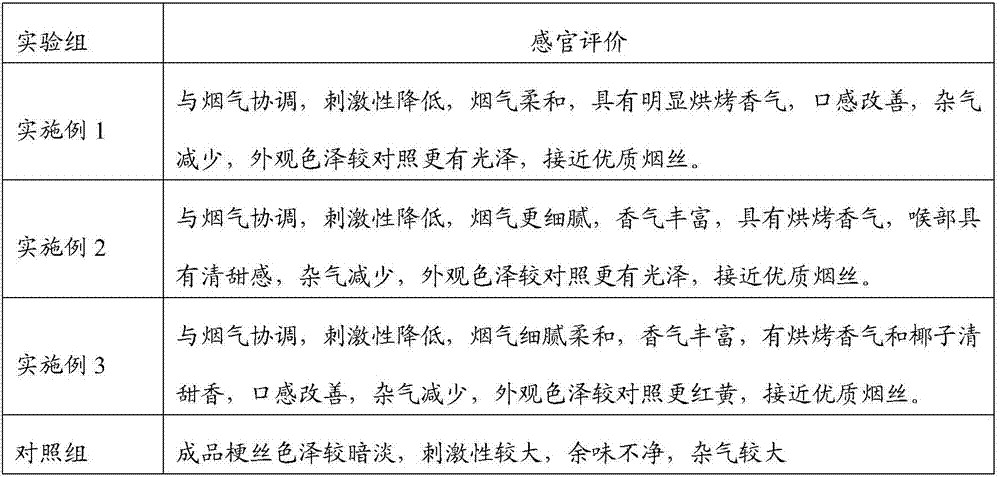Method for improving quality of cut stems by aspartic acid based solid-phase Maillard reaction
A technology of Maillard reaction and aspartic acid, which is applied in the field of tobacco processing, can solve the problems of short Maillard reaction time, long process time, and poor aroma enhancement effect, and achieve large-scale industrial application prospects and improve sensory perception Quality, reduce the effect of smoke irritation and miscellaneous gas
- Summary
- Abstract
- Description
- Claims
- Application Information
AI Technical Summary
Problems solved by technology
Method used
Image
Examples
Embodiment 1
[0029] A method for improving the quality of cut stems by aspartic acid solid-phase Maillard reaction, comprising the following steps:
[0030] (1) raw material preparation: aspartic acid and mannose (molar ratio is 3:1) as solid-phase Maillard reaction substrate, account for 0.05% of the cut stem quality, reaction catalyst is ammonium acetate, ascorbic acid (mass ratio is 1:1), the catalyst mass accounts for 0.25% of the Maillard reaction substrate mass; the mass ratio of water to the Maillard reaction substrate is 2:1;
[0031] (2) Solid-phase Maillard reaction in the shredded stem feeding process: add water, aspartic acid, and mannose at 65°C in sequence according to the ratio of raw materials in the above step 1), and stir thoroughly until they are completely dissolved, then add the reaction catalyst (ammonium acetate, ascorbic acid), mix evenly, evenly spray on the shredded stems, make the moisture content of the shredded stems reach 30%, and carry out solid-phase Maillar...
Embodiment 2
[0036] A method for improving the quality of cut stems by aspartic acid solid-phase Maillard reaction, comprising the following steps:
[0037] (1) Raw material preparation: amino acid (aspartic acid and asparagine, molar ratio 1:1) and fermented coconut extract are used as solid-phase Maillard reaction substrate, account for 0.12% of stem shredded mass, described amino acid and The mass ratio of fermented coconut extract is 2.8:1, and reaction catalyst is decanaldehyde, ascorbic acid (mass ratio is 1:1), and catalyst quality accounts for 0.3% of Maillard reaction substrate quality; Water and Maillard reaction substrate The mass ratio is 2.5:1;
[0038] (2) Solid-phase Maillard reaction in the shredded stem feeding process: add water at 72°C, amino acids, and fermented coconut extract according to the ratio of raw materials in the above step 1) in turn, stir thoroughly until completely dissolved, then add the reaction catalyst, Mix evenly, spray evenly on the shredded stems, ...
Embodiment 3
[0044] A method for improving the quality of cut stems by aspartic acid solid-phase Maillard reaction, comprising the following steps:
[0045] (1) Raw material preparation: Amino acid (aspartic acid and asparagine are compounded at a molar ratio of 0.5:1) and complex sugar source as solid-phase Maillard reaction substrate, accounting for 0.2% of the cut stem mass, the compound Sugar source is the mixture (mass ratio of 1:1) of rhamnose and fermented coconut extract, the mass ratio of described amino acid and complex sugar source is 3:1, and reaction catalyst is ammonium acetate, ammonium bicarbonate (mass ratio is 1:1), the catalyst mass accounts for 0.5% of the Maillard reaction substrate mass; the mass ratio of water to the Maillard reaction substrate is 4:1;
[0046] (2) Solid-phase Maillard reaction in the shredded stem feeding process: add water at 80°C, amino acids, and complex sugar sources according to the ratio of raw materials in the above step 1) in sequence, and s...
PUM
 Login to View More
Login to View More Abstract
Description
Claims
Application Information
 Login to View More
Login to View More - R&D
- Intellectual Property
- Life Sciences
- Materials
- Tech Scout
- Unparalleled Data Quality
- Higher Quality Content
- 60% Fewer Hallucinations
Browse by: Latest US Patents, China's latest patents, Technical Efficacy Thesaurus, Application Domain, Technology Topic, Popular Technical Reports.
© 2025 PatSnap. All rights reserved.Legal|Privacy policy|Modern Slavery Act Transparency Statement|Sitemap|About US| Contact US: help@patsnap.com



